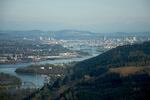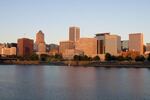
Is the Willamette, the Northwest's most urbanized stretch of river, now safe for swimming?
Sam Beebe/Flickr
Portland’s stretch of the Willamette River isn’t all sewage and Superfund toxins.
In fact, for most of the summer it’s clean enough to swim in downtown.
This weekend, the environmental nonprofit Willamette Riverkeeper is hosting a new event called The Big Float to celebrate the good news about the city's much-maligned waterway: It's a lot cleaner than it used to be.
“We’re at a point at which you can say for recreating and swimming, you’re in pretty good shape,” says Willamette Riverkeeper Executive Director Travis Williams. “You can swim in it, get wet, and you’re going to be fine. There’s no bacteria or toxic that can get to you.”
Nearly a thousand people are signed up to strip down to their swimsuits and jump in the river on Sunday. They will meet up at the southeast base of the Hawthorne Bridge with inner tubes and other inflatable devices and float across the river right in the middle of the city.
That is, as long as it doesn’t rain too much between now and then.
“If it rains 48 hours before the event we will not get in the river. That's an absolute concern if it rains,” says event organizer Will Levenson. “If it doesn't rain, it's just fears that have no foundation of truth in them, which is a lot of what Portland feels right now.”
A big part of the Willamette’s bad reputation comes from sewer overflows that follow big rain events. The city’s old pipes combine sewage and stormwater and spill bacteria-laden water into the Willamette River when it rains a lot.
But those events are becoming less and less frequent – especially in the summertime.
Since 2000, the city of Portland has built three big pipes that send combined sewage to a wastewater treatment plant. The third of those pipes, the East Side Big Pipe, is scheduled to be completed this fall. When it’s done, sewer overflow events will drop by 94 percent, according to Portland’s Bureau of Environmental Services.
“Minus the combined sewer overflow problem, you can come out here and have a good time,” says Williams. “By the conclusion of this calendar year, the City of Portland will have put in the big pipe project, which will intercept a high percentage of the combined sewer overflow events that would have occurred under the old system. It gets at the heart of what a lot of people say about the river – that it’s really gross.”
The river's water quality has steadily improved over the past 10 years, according to Doug Drake, lower Willamette Basin coordinator for Oregon Department of Environmental Quality. The state agency has a fact sheet entitled "Is it safe to swim in the Willamette?"
“In general, the water quality parameters we track are improving,” Drake says. “Bacteria is one that’s most improved. What that really translates into for people is that it’s safe to swim. It doesn’t mean we’ve solved all the problems. The toxics are at really low levels that are more of an issue for fish and critters.”
The Willamette may not be full of sewage anymore, but it’s not the model of clean water either.It’s still a major contributor of contaminants into the mainstem Columbia, says Environmental Protection Agency Columbia River coordinator Mary Lou Soscia.
“There’s municipal pollution, industrial pollution, agricultural pollution, emerging contaminants like pharmaceuticals and flame retardants, and mercury,” she says. “There’s a lot of pollution in the Willamette River. It’s the most developed area. It’s where a lot of people live. Where there’s people there’s going to be pollution from a lot of sources.”
The heavily industrialized Portland Harbor site is still listed as a contaminated Superfund clean-up site. And it’s still major concern for water quality in the Willamette and the larger Columbia River Basin, Soscia says. Recent studies have shown the legacy industrial compounds polychlorinated biphenyls, or PCBs, are still active in the Columbia River water column. They’ve also been detected in outmigrating juvenile salmon downstream from Bonneville Dam.
“My theory is those PCBs are coming from Portland Harbor,” Soscia says. “The sooner the clean up, the better the condition of the Columbia River is going to be.”
But not only is Portland Harbor downstream from downtown Portland, it’s not releasing toxins at levels that can harm people in the water or even in the sediment.
“We’re very concerned about the Willamette, but at the same time we see a lot of progress,” Soscia says. “If you lived in the river you might have some sort of long term, sustained impact that would not be good. But it’s totally safe to swim in the river.”
Williams agrees there are still many issues on the river that need to be addressed, and he hopes The Big Float will help raise awareness of them.
“We take the toxics issue very seriously,” Williams says. “In getting folks out there, we can get them interested in the real issues that continue to plague the river.”
_ Look for more from Cassandra Profita on the Big Float and other environmental issues at OPB's Ecotrope. _

